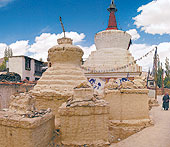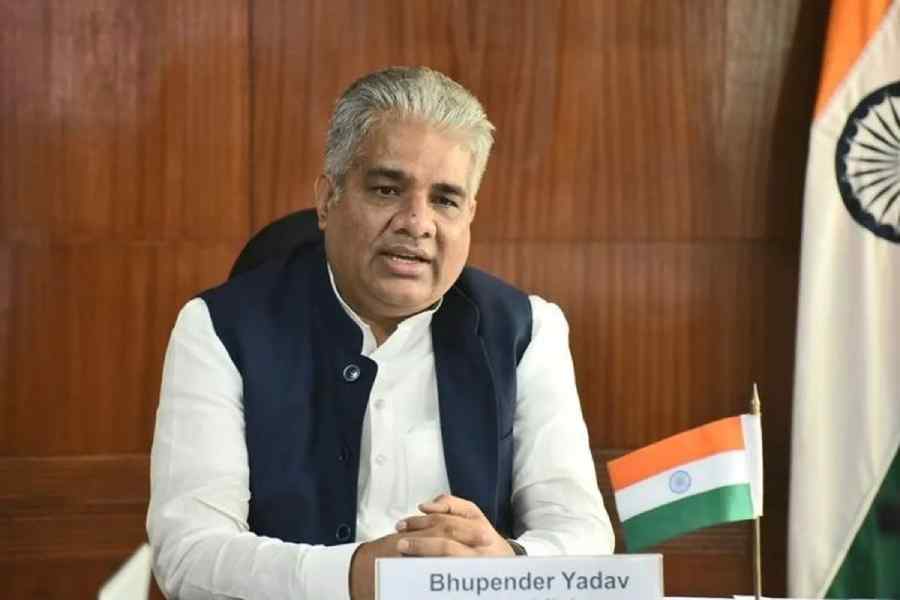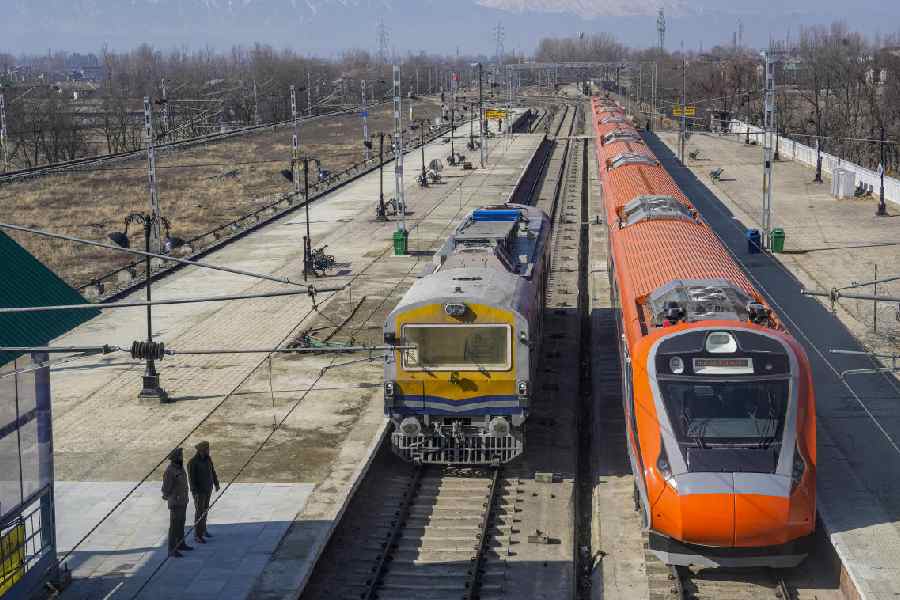 |
 |
 |
| (From top): A view of beautiful Ladakh; young Buddhist monks; a section of the monastery at Thiksey |
There are not too many places left on earth where you can go to meet yourself. Where most travel destinations promise you white beaches, azure lagoons and coral reefs, or seduce you with shopping and nightlife ? Ladakh offers you only its emptiness. In its vast open spaces, its silence and austerity, you may learn to sense and experience in ways you have never conceived before. Ladakh addresses the spirit, distinctly and directly, cutting through the clutter to unsheathe your very soul.
Ladakh is one of the three distinct regions of J&K State, the other two being the Kashmir Valley and Jammu. So disparate are these three regions culturally, geographically and demographically, that they could well be three separate states.
Culturally Ladakh is Tibetan ? language, art, architecture, medicine and music, all mirror this affinity. The Suru Valley and Kargil regions are predominantly Muslim and are culturally close to Baltistan in Pakistan. Leh and the Indus Valley is largely Buddhist.
The early morning flight from Delhi follows the morning sun on the Zanskar range. When you touch down at Leh Airport, the first thing that strikes you is the crystalline quality of the light, as though someone had wiped the dust off your spectacles. The second thing you notice is the very visible presence of the Army.
The first two days are spent resting and acclimatising, and drinking endless cups of tea ? milk tea, mint tea, ginger tea, chamomile tea and, a never-to-be-repeated sip of butter tea. The altitude varies from 3,500 metre to 5000 metres approximately, which means that visitors arriving by air need at least 36 hours to acclimatise to the thin air. Even moderate exertion during this time could mean having to be airlifted back to Delhi in an oxygen tent!
| A matter of faith |
| Roughly half of Ladakh’s population are practising Buddhists. Nearly every family has a member who is a monk (lama) or a nun (chomo). This pervasive religiosity is seen in the many monasteries (gompas) that dot Ladakh, sometimes growing out of craggy outcrops, sometimes nestled in green valleys and sometimes mirrored in still lakes. Each of these enshrine towering statues in clay or polished copper of one of the many incarnations of the Buddha. At their feet flicker butter-lamps lit by the faithful. • Shey Gompa: Shey, 15 km south of Leh, was once the royal residence. |
On the third day, we set off to discover the sights and sounds of Leh town. Ladakh is one of India’s most remote regions and was opened up to tourists only as recently as 1974. But the impact of the backpacker brigade is already visible all over Leh bazaar ? Pumpernickel bakeries selling brownies and cinnamon rolls, meditation courses run by “The Old Swami from Rishikesh”, courses in Ashtang and Hatha Yoga even a ‘Cleopatra Milk Bath’ involving 33 litres of goat milk! Aggressive Israeli men swagger past Mani walls, and underdressed Latino girls laugh loudly in roadside caf?s. But it’s a lovely day and we stop to turn a prayer-wheel by the road. Friendly Ladakhi’s call out ‘Julay!’ ? an all-purpose word to express hello, goodbye, welcome, thank-you, and the only word you really need to know here in Ladakh. Soon a sense of well-being descends on us and we find ourselves “Julay julay”-ing with the rest of them. We settle down at a little caf? to a wonderful meal of momos and hot thick Ladakhi bread.
Leh town and nearby Choglamsar are full of curios in turquoise, lapis-lazuli and amber. The perak, a headgear worn by married Ladakhi women on festive occasions are studded with scores of turquoise. There are carved and painted tea-tables made of the willow that grows in profusion along the banks of the Indus.
A recommended buy is the goncha worn by Ladakhi men. It is a knee-length handspun robe worn over trousers, with a bright belt tied around the hips ? an ensemble that would make an elegant style statement at any high society ‘do’ in the city.
| Fact file |
| Getting there: There are daily flights from Delhi to Leh, by Jet Airways and Indian Airlines. By road, you could do the 475km Manali to Leh journey. The highway is open from mid-June to mid-September depending on weather conditions. The 12hr drive can be done over 2 days with a night halt at Sarchu. Climate: Summer (May to September) is warm, though light woollens are required in the evening. Pack sunscreen lotions, hats and dark-glasses. |
But it is really when you leave Leh and travel out into the desert that you feel the transcendental power of Ladakh. Because of the altitude, there is little suspended particulate matter, so the clarity is dazzling. At noon, the sun is like a giant light source that is everywhere at once. There are no shadows on the rounded brown hills and the eye can see more sharply than ever before. The sky is a deep lapis with cotton-wool cumulus cloud, like a child’s impossibly idealised painting. Our vehicle is a tiny dot in a vast upturned emptiness. Empty, yet filled with a presence you can almost touch.
The road to the Nubra Valley, some 140km. from Leh takes you through Khardong-la, the world’s highest motorable road at a height of 5,600 metres. However, this is also the road to Siachen Glacier, so you are also likely to encounter the world’s highest traffic jam, as lorries ferry supplies to this frozen outpost.
The road rolls down the Old Silk Route to the three green oases of Tirit, Tigger and Panamik along the River Nubra. There are pretty villages in the middle of nowhere, cultivated fields and fruit orchards. At Panamik, there are hot sulphurous springs. Where else in the world can you soak in the healing energies springing from the earth’s hot core, under the canopy of a turquoise sky, and shielded from the gaze of the world by an amphitheatre of frozen mountains?
The memory of a diamond-studded Nubra night-sky is one that will remain with you long after you are back in the world of board-meetings and ringing cellphones. Ladakh takes a hold of you in a way you discover only when you get home. For the rest of your life you will find reasons to return.
Photographs by Amit Pasricha
Quick beach fixes
 |
 |
Life in Mumbai is like a busy freeway with everyone racing off to their next destination. With a million cars on the road and hordes of people breathing down each other’s necks, the city of dreams can easily become an overwhelming experience. The only remedy is a quick getaway — fortunately not too hard to find. The city’s extensive coastline offers a host of picnic spots and options for day-long jaunts.
So grab your sunhat and let us take you on a few crowd-beating excursions. Along the northern coast lie several choices where you can escape the ratrace and chill out. Manori Beach, Gorai Beach, Aksa Beach, Utan Village are all a couple of hours away from the main city. Easily reachable from the western suburbs of Malad and Borivilli, the beaches offer a host of dining and lodging options if you want to stay overnight. But the ruins, the sand and the Arabian Sea are what one must look out for.
The twin beaches of Gorai and Manori are a quick hop from Malad via a 5-minute ferry ride. Part of the Portuguese colony, Manori and Gorai have a predominately East Indian population with crumbling churches, Portuguese ruins and small fishing hamlets. The island beaches are Mumbai’s few stretches of sand that are still untouched by modern life. Dotted with quaint villages on either side, the islands of Manori and Gorai offer peaceful retreats. Sights of dried fish, kids running hither and thither and palm trees swaying greet the visitor.
The locals here rent out rooms for overnight visitors at nominal rates of Rs 50 to Rs 100. But you want to live it up? State-of-the-art resorts too have mushroomed in the past few years — Manori Bel, Domnicas and Pali Beach Resort are some famous ones. Utan Beach, at the northern tip of the Gorai island is a fishing village with a beautiful coastline. Fishing boats laze on the beach while Bombay Duck dries in rows in front of small shrines of Mother Mary. U-Tan, the only resort in the village atop a cliff offers a breathtaking view of the rocky beach.
But if all this idyllic scenery is too tame for you, then the action-packed Esselworld may grab you. Located on Manori island, Esselworld has its own ferry service that carries tourists across for an excitement-filled day. The newly built Water Kingdom is situated right next to the theme park and is open year-long with the exception of the monsoon months between June and September.
The Dahanu-Bordi belt in Thane district — Central Mumbai — too has a clutch of good beaches down the coast. Towards Gujarat, the journey is a scant few hours and easily doable by road or rail. Fringed with casuarinas, Bordi is a safe beach where water does not reach above the waist for half a kilometre. The entire 17 km stretch from Dhanu to Bordi offers beautiful scenery with its backdrop of orchards featuring various fruits, notably chikoos.
Besides the MTDC resort, one can also put up in spacious Parsi bungalows on the beach. It’s an ideal place to unwind as there’s nothing much by way of tourist attractions besides the sand and the endless sea.
Another easily reachable getaway is Kelve Beach just eight km from Palghar station in Thane district. The only problem is that with the largest stretch of coastline — around 7 kms, the place is packed over weekends with visitors from Mumbai, Vapi, Valsad and other places. But escape from the city on a weekday and you’ll have the place much more to yourself. And for the religious-minded, the Sheetladevi Temple is near the beach. For those who like to combine a beach outing with shopping, there’s an annual fair in June.
Alibaug, yet another idyllic getaway on the western coast of India, is a three-hour drive from Mumbai. Launches for Mandwa and Alibaug leave the Gateway of India every 15 minutes. Catamarans too, are available at regular intervals. Alibaug has a number of lovely, unspoiled beaches. A historic fort that is now in ruins is located off the beach and the hill range of the Western Ghats line the other side of the town giving it a unique character of greenery and the blue of the ocean. An unhurried pace of life characterises the town free of pollution and noise.
An old town relating to the Marathas, Alibaug is about 300 years old. Twelve miles from the town, you will find two beach fronts — Mandwa and Kihim. Mandwa is a beautiful, untrodden beach. On a clear day, one can enjoy a breath-catching view across the bay, up to the Gateway of India. Mandwa village too, has a charm of its own — with its beautiful groves of coconut palms.
Unspoilt and isolated, Kihim beach has a soothing effect on anyone suffering from city blues. For nature lovers, Kihim has a lot to offer — woods filled with wild flowers and rare butterflies and birds. The Kolaba Fort, a few hundred yards from the shore, is worth spending some time. And 15 kms from Alibaug is Chaul, a historic place with Portuguese ruins, Buddhist caves, the Hamam Khana, a church, a temple and even a synagogue.
Sounds tempting? Pack your bags.
Route map
Here’s an innovative offer from Lufthansa. The German airline is trying to lure more passengers for its new flights to West Asia. So, it has tied up with Air-India. The offer’s great for passengers who’ve been considering a pilgrimage to Jeddah or dying to shop in Dubai. You can now build in a stopover at Abu Dhabi, Muscat, Dubai, Kuwait or Jeddah, en-route to Frankfurt or Munich (or make the stop on the way back). Here’s how it works: Lufthansa and Air India have come together so passengers can fly to any of the five destinations in the Middle East on Air-India on your way to Europe and hop on to a Lufthansa flight for the onward journey. Or, passengers can stop over in the Middle East on their way back, flying the last leg back home on A-I. The triangular fares are mileage-based (depending on where you stopover), beginning at Rs 37,485.
The Big Apple just got a bit closer for people who live in Chennai. Starting this month Delta is flying daily from Chennai to New York via Paris. The airline, that has been operating in India since 1991 is targeting business and leisure travellers and has tailored the flights for Indians. That means it will serve a very Indian menu, with channa dal, chicken Nilgiri korma and saffron rice and show Tamil movies all the way to the Big Apple. The airline is flying Boeing 767-300ER planes that seat 204 people.
My favourite holiday
 |
Piu Sarkar,
painter/actress
Five months ago, my family and I had gone to the Neora Valleys in the Dooars. I’m always drawn to places that allow me to reconnect with nature. I can’t explain how rejuvenated I feel surrounded by greenery and forests. Also, while jungle getaways can be quite thrilling, they also offer a sense of peace and solitude. Naturally then, I thoroughly enjoy a vacation to the hills. In fact, the higher I go, the better I feel.
Before reaching the Neora Valleys, we’d already gone to Lava Lolegaon, Santalicola and Gorumara Forest, all in the same belt. I also went trekking to Reshop. Once we arrived in Neora Valleys, we put up in a nice lodge. And here I spent 20 days of pure bliss!
Many would wonder at how boredom doesn’t creep in when visiting a place that really has nothing to offer besides its natural beauty. But I wasn’t bored at all. Every day, I’d awake at five and go for a long walk, revelling in the fresh air and listening to the birds chirping. I also loved interacting with the locals there. These are simple people living simple lives and yet there was so much to talk about. It’s these small things that inspire me when it comes to my painting.










